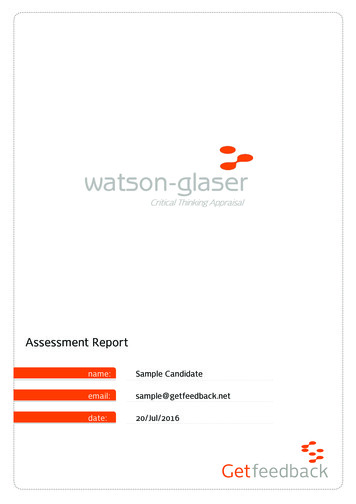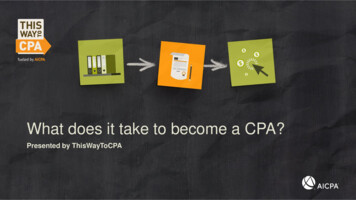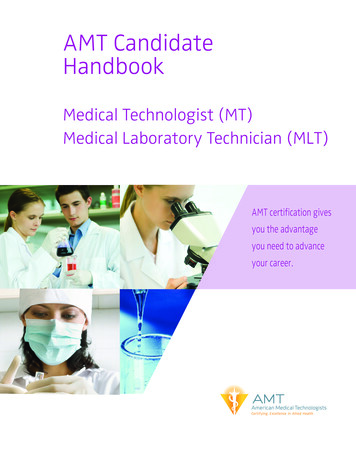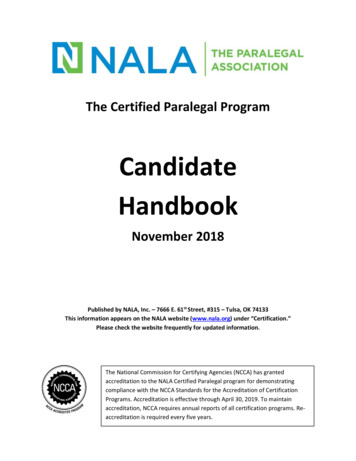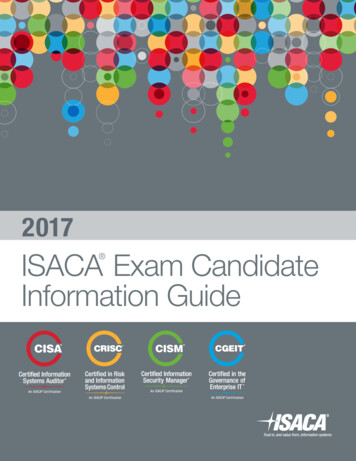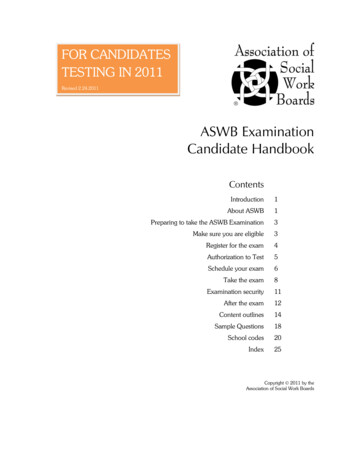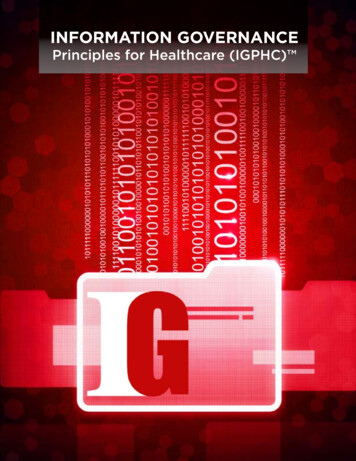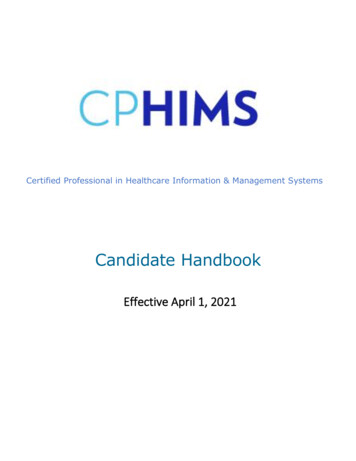
Transcription
Certified Professional in Healthcare Information & Management SystemsCandidate HandbookEffective April 1, 2021
For questions regarding HIMSS certification programs, contact:Healthcare Information and Management Systems Society33 West Monroe Street, Suite 1700Chicago, IL 60603-5616Phone: 703-722.0580Email: certification@himss.orgWebsite: ight 2020 by Healthcare Information and Management Systems Society. All rights reserved. Any duplication orreproduction of all or any of these materials without the express written permission of HIMSS is prohibited.Controlled DocumentCPHIMS Candidate HandbookApproved by: M GrossPage 1 of 27Effective Date: April 1, 2021
Candidate HandbookTable of ContentsContentsTable of Contents . 2CPHIMSCandidateHandbookandApplication . 3AboutHIMSS. 3HIMSS Vision. 3HIMSS Mission . 3HIMSSCertificationProgramExaminations. 3CPHIMSCertificationProgram . 4CPHIMSEligibilityRequirements . 4CPHIMSExamination . 5CPHIMSExaminationPreparation . 9Review the Content Outline and Competency GapAssessment . 9Develop a Learning Plan . 9Complete the CPHIMS Practice Exam Error! Bookmarknot defined.The CPHIMS Review Guide, 3rd Edition . 9HIMSS Dictionary of Healthcare InformationTechnology Terms, Acronyms and Organizations, FifthEdition. 10Inclement Weather or Emergency . 16Failing to Report for the CPHIMS Examination. 17Rules for CPHIMS Examination . 18CopyrightedExaminationQuestions. 19Testing Experience . 19FollowingtheCPHIMSExamination . 20ScoreReports. 20How the CPHIMS Passing Score is Set. 20Passing the CPHIMS Examination . 21Failing the CPHIMS Examination. 21Scores Cancelled by HIMSS. 21ScoreConfidentiality . 21AdministrativeMatters . 21Name and Address Change. 21Failing to Renew. 22Appeals . 23Checklist for BecomingCertified . 24Contacting HIMSS Certification . 24Request for Accommodations . 25Documentation of Disability Related Needs . 26CPHIMSExaminationAdministration . 10Computer Administration at Pearson Vue AssessmentCenters . 10Testing Outside of the United States. 11Special Arrangements for Candidates with Disabilities. 11Adhering to Professional Standards of Conduct and Terms ofConfidentiality . 12CPHIMSExaminationApplicationandSchedulingProcess . 14Online Application and Scheduling . 14Special Accommodations . 15English as a Second Language . 15Re-Scheduling or Cancelling a CPHIMS Examination . 15On the Day of the CPHIMS Examination . 16Reporting for the CPHIMS Examination . 16On-SiteSecurity . 16IdentityVerification . 16Use of Calculators . 16Controlled DocumentCPHIMS Candidate HandbookApproved by: M GrossPage 2 of 27Effective Date: April 1, 2021
Candidate HandbookCPHIMS Candidate Handbook and ApplicationThis Candidate Handbook provides information about the Certified Professional in Healthcare Information andManagement Systems (CPHIMS) program, including CPHIMS Examination administration policy and process as well asthe CPHIMS Examination Application. Keep this Candidate Handbook until after the examination is completed.Additional copies of this Candidate Handbook may be obtained by downloading a copy online. The most currentversion of the Candidate Handbook is posted here and supersedes any other version.About HIMSSHIMSS is a global advisor and thought leader supporting the transformation of health through information and technology.As a mission driven non-profit, HIMSS offers a unique depth and breadth of expertise in health innovation, public policy,workforce development, research and analytics to advise global leaders, stakeholders and influencers on best practices inhealth information and technology. Through our innovation companies, HIMSS delivers key insights, education andengaging events to healthcare providers, governments and market suppliers, ensuring they have the right information atthe point of decision. Headquartered in Chicago, Illinois, HIMSS serves the global health information and technologycommunities with focused operations across North America, Europe, United Kingdom, the Middle East and Asia Pacific.Our members include more than 72,000 individuals and 630 corporate organizations.HIMSS VisionA world where everyone, everywhere, has access to a health and wellness ecosystem that works - one with the humanat its heart.HIMSS MissionTo reform the global health ecosystem by leveraging the power of information and technology. By creating aninformed and empowered community of providers, innovators and individuals, we will enable an ever-improving stateof health and wellness throughout the world.Statement of NondiscriminationHIMSS does not discriminate among candidates on the basis of age, gender, race, color, religion, national origin,disability or marital status.HIMSS Certification Program ExaminationsHIMSS conducts certification examinations for programs in healthcare information and management systems: CPHIMS (Certified Professional in Healthcare Information and Management Systems) CAHIMS (Certified Associate in Healthcare Information and Management Systems)Each certification examination is designed to test a well-defined body of knowledge representative of professionalpractice in healthcare information and management systems. Successful completion of a certification examinationis an indicator of broad-based knowledge in healthcare information and management systems. Certificationexaminations conducted by HIMSS are independent of each other. Each leads to a certification credential inhealthcare information and management systems.Content of each examination was defined by an international or national role delineation study. The study involvedsurveying practitioners in the field to identify tasks that are performed routinely and considered important tocompetent practice. Each edition of a certification examination is developed through a combined effort of qualifiedControlled DocumentCPHIMS Candidate HandbookApproved by: M GrossPage 3 of 27Effective Date: April 1, 2021
Candidate Handbooksubject-matter experts and testing professionals, who construct the examination in accordance with the ExaminationContent Outline.Testing AgencyHIMSS contracts with Pearson Vue, Inc. to assist in the development, administration, scoring, score reporting andanalysis of the CPHIMS Examination. You can learn more here.CPHIMS Certification ProgramThe CPHIMS certification program promotes the healthcare information and management systems field throughcertification of qualified individuals and the following program elements: Recognizing formally those individuals who meet the eligibility requirements of CPHIMS and pass the examination Requiring certification renewal through continued personal and professional growth in the practice of healthcareinformation and management systems Providing an international standard of requisite knowledge for certification; thereby assisting employers, the publicand members of health professions in assessing healthcare information and management systems professionalsCPHIMS Eligibility RequirementsEligibility requirements beginning 1 January 2020Candidates who meet eligibility requirements and pass the CPHIMS Examination attain the CPHIMS designation. HIMSSreserves the right, but is not obligated to, accuracy of information supplied by or on behalf of a candidate.Eligibility for the CPHIMS Examination requires fulfilling one (1) of the following requirements: Baccalaureate degree from an accredited college or university plus five (5) years of information and managementsystems hands-on work experience. Information and management systems experience refers to work experience insystems analysis; design; selection, implementation, support, and maintenance; testing and evaluation; privacy andsecurity; information systems; clinical informatics; management engineering. Of those five (5) years of experience, atleast three (3) of those years must be in a healthcare setting. A healthcare setting is defined to include experience with aprovider of health services or products to a healthcare facility (e.g., hospital; healthcare consulting firm; vendor;federal, state, or local government office; academic institution; payer; public health, etc.). Graduate degree or higher from an accredited college or university plus three (3) years of information and managementsystems experience. Information and management systems experience refers to work experience in systems analysis;design; selection, implementation, support, and maintenance; testing and evaluation; privacy and security;information systems; clinical informatics; management engineering. Of those three (3) years of experience, at least two(2) of those years must be in a healthcare setting. A healthcare setting is defined to include experience with a provider ofhealth services or products to a healthcare facility (e.g., hospital; healthcare consulting firm; vendor; federal, state, orlocal government office; academic institution; payer; public health, etc.). Ten (10) years of information and management systems experience. Information and management systemsexperience refers to work experience in systems analysis; design; selection, implementation, support, andmaintenance; testing and evaluation; privacy and security; information systems; clinical informatics; managementengineering. Of those ten (10) years of experience, at least eight (8) of those years must be in a healthcare setting. Ahealthcare setting is defined to include experience with a provider of health services or products to a healthcare facility(e.g., hospital; healthcare consulting firm; vendor; federal, state, or local government office; academic institution;Controlled DocumentCPHIMS Candidate HandbookApproved by: M GrossPage 4 of 27Effective Date: April 1, 2021
Candidate Handbookpayer; public health, etc.CPHIMS ExaminationThe CPHIMS Examination is structured as follows: Composed of 115 multiple-choice questions. A candidate’s score is based on 100 of these questions. Fifteen (15) are‘trial’ or ‘pretest’ questions that are interspersed throughout the examination. A candidate is allowed two (2) hours in which to complete the CPHIMS Examination. The CPHIMS Examination is based on the four (4) major content areas listed in the Outline of Exam Topics. CPHIMS Examination questions are categorized by the following cognitive levels:— Recall (RE): ability to recall or recognize specific information— Application (AP): ability to comprehend, relate or apply knowledge to new or changing situations— Analysis (AN): ability to analyze and synthesize information, determine solutions or evaluate thesolutions.CPHIMS Outline of Examination TopicsEffective 1 July 2019Healthcare and Technology Environments – 25%A. Healthcare EnvironmentA.1 Articulate characteristics and services of different types of healthcare organizations (e.g., hospitals, clinics,ambulatory centers, community health organizations, healthcare payers, regulators, research and academic)A.2. Articulate characteristics of interrelationships within and across healthcare organizations (e.g., health informationexchange, public, private, continuity of care)A.3. Describe the roles and responsibilities of healthcare information and management systems professionals within theorganizational structures in which they workA.4. Recognize the impact of commonly accepted laws, regulations, accreditation and other state and local rules thatgovern critical healthcare information and systems management services, including privacy, safety and security (e.g.,privacy regulations, pharmacy, environments of care, patient rights) on the healthcare industryA.5. Evaluate trends in healthcare technology and implement strategies to improve patient outcomes (e.g., telemedicine,patient portals, wearable devices, population health)B. Technology EnvironmentB.1. Articulate characteristics of applications commonly used in healthcare (e.g., clinical, administrative, financial,consumer, business intelligence)B.2. Articulate characteristics of technology infrastructure that support the healthcare environment (e.g., network,communications, data integration, privacy and security)Clinical Informatics – 20%A. Clinical InformaticsA.1. Identify basic clinical vocabulary/terms frequently represented in healthcare informatics (e.g. dosage frequency,dosage routes, body systems)Controlled DocumentCPHIMS Candidate HandbookApproved by: M GrossPage 5 of 27Effective Date: April 1, 2021
Candidate HandbookA.2. Identify basic healthcare IT vocabulary/terms frequently represented in healthcare informaticsA.3. Identify basic clinical metrics frequently represented in informatics (e.g., average daily census, turnaround time,adherence, barcode medication administration)A.4. Develop and implement system functionality to optimize clinical effectiveness and efficienciesA.5. Interpret clinical and operational outcomes through the use of various data analytics tools (e.g., reports, tables,graphs, charts, predictive models)A.6. Develop mechanisms to facilitate ongoing clinical content and decision-support toolsHealthcare Information and Systems Management - 30%A. AnalysisA.1. Apply appropriate concepts of systems development (e.g., systems development lifecycle or SDLC)A.2. Apply and utilize project management methodology components (e.g., needs analysis, gap analysis, defining andprioritizing requirements)A.3. Apply appropriate concepts of process improvement (e.g., DMAIC, PDCA)A.4. Utilize standard visualization tools to analyze and improve current business and clinical processes (e.g., processmapping, flow diagramming, gap analysis)A.5. Interpret and analyze disparate data setsA.6. Formulate alternate processes and potential solutions for new or improved applications and/or systemsA.7. Evaluate if a proposed solution aligns with the organization's strategic and operational plansA.8. Perform cost-benefit analysis to evaluate impact on issues related to healthcare systems (e.g., customer satisfaction,patient care quality, economics, access to care, business process improvement)A.9. Develop proposals that include recommended approaches and solutions, and plans for realizing benefitsA.10. Analyze and interpret business documentation to promote system changes and/or implementations (e.g., RFPs,RFIs, SLAs, SOWs, NDAs, etc.)B. DesignB.1. Ensure interoperability of software, hardware, network components and medical devicesB.2. Ensure compliance with applicable industry, regulatory and organizational standardsB.3. Ensure a process exists to incorporate industry, technology, infrastructure, legal and regulatory environment trendsB.4. Design an information infrastructure that supports current and anticipated business needs (e.g., business continuity,disaster recovery)B.5. Evaluate existing and emerging technologies to support organization's future growth and strategyB.6. Employ and implement effective data management using an established data governance protocolC. Selection, Implementation, Support and MaintenanceC.1. Conduct solution selection activities (e.g., identify organizational stakeholders, demonstrations, site visits, referenceC.2. Employ effective technical change management practices checks)C.3. Identify and execute effective training and support methods (e.g., computer-based learning, classroom training, trainthe trainer, at-the-elbow support from superusers)C.4. Implement solutions while managing scope, schedule, budget, and qualityC.5. Maintain healthcare information systems (e.g., operate, upgrade)C.6. Analyze data for problems and trends (e.g., error reports, help desk logs, surveys, performance metrics, networkmonitoring)D. Testing and EvaluationControlled DocumentCPHIMS Candidate HandbookApproved by: M GrossPage 6 of 27Effective Date: April 1, 2021
Candidate HandbookD.1. Administer a formal testing methodology (e.g., unit test, integrated test, stress test, acceptance test)D.2. Implement and monitor compliance with internal controls to protect resources and ensure availability, confidentialityand integrity during testing (e.g., security audits, versioning control, change control)D.3. Validate implementations against contractual terms and design specificationsD.4. Evaluate that expected benefits are achieved and report metrics (e.g., return on investment, benchmarks, usersatisfaction)E. Privacy and SecurityE.1. Define and implement organizational policies and procedures to ensure confidentiality, privacy, security, availability,and integrity of dataE.2. Assess and mitigate privacy and security vulnerabilitiesE.3. Define and implement user access controls according to established policies and proceduresE.4. Assess and implement physical, technical, and administrative controls to ensure safeguards are in place to protectassets (e.g., servers secured, unattended computers, two-factor authentication)E.5. Define organizational roles responsible for managing vulnerabilities (e.g., information security, physical security,compliance)E.6. Develop and implement data management controls (e.g., data ownership, criticality, security levels, protectioncontrols, retention and destruction requirements, access controls)E.7. Validate on an ongoing basis the security features of existing systemsManagement and Leadership – 25%A. Management and LeadershipA.1. Contribute to organizational strategic planning (e.g., measure performance against organizational goals)A.2. Assess the organizational environment (e.g., corporate culture, values and drivers)A.3. Forecast technical and information needs of an organization by linking resources to business needsA.4. Develop and implement an IT strategic plan and departmental objectives that align and support organizationalstrategies and goalsA.5. Evaluate performance (e.g., SLAs, goal/performance indicators, systems effectiveness)A.6. Evaluate effectiveness and user satisfaction of systems and services being providedA.7. Promote stakeholder understanding of information technology opportunities and constraints (e.g., business and ITresources, budget, project prioritization)A.8. Develop policies and procedures for information and systems managementA.10. Understand and comply with the organization's ethical business principles A.9. Comply with legal and regulatorystandardsA.11. Employ comparative analytics (e.g., indicators, benchmarks)A.12. Prepare and deliver business communications (e.g., presentations, reports, project plans)A.13. Facilitate group discussions and meetings (e.g., consensus building, conflict resolution)A.14. Provide consultative technology services to the organizationA.15. Develop educational strategies for the information and management systems functionA.16. Maintain organizational competencies on current IT technologies and trendsA.17. Apply effective risk management to internal and external processes (e.g., risk assessment, risk mitigation)A.18. Maintain effective and ethical working relationships with internal and external stakeholders (e.g., clinicians,vendors, partners)Controlled DocumentCPHIMS Candidate HandbookApproved by: M GrossPage 7 of 27Effective Date: April 1, 2021
Candidate HandbookA.19. Present interpretations and recommendations of data analyses to decision makersA.20.Employ organizational change management techniques in support of solution implementationA.21. Define roles, responsibilities and job descriptions for healthcare IT functionsA.22. Evaluate staff competency in information and management systems skillsA.23. Manage projects and portfolios of projectsA.24. Manage contractual agreements with vendors and partner (e.g., contract cost, schedule, support, maintenance,performance)A.25. Manage budget and financial risksControlled DocumentCPHIMS Candidate HandbookApproved by: M GrossPage 8 of 27Effective Date: April 1, 2021
Candidate HandbookCPHIMS Examination PreparationThe method of preparation and amount of time spent preparing for the CPHIMS Examination can be driven by avariety of factors, including the candidate’s preferred study style, level of professional experience, or academicbackground. Some methods of preparation may include but are not limited to the following methods:Review the Content Outline and Competency Gap AssessmentCandidates should begin by reviewing the CPHIMS Examination Content Outline. Review the content categoriesand related tasks. Identify and focus review on tasks that you do not perform regularly or with which you are notfamiliar. Remember that all questions in the CPHIMS Examination are job-related/experience-based and test theapplication and analysis of information, not just the recollection of isolated facts. The best way to conduct thisreview is to use Competency Gap Assessment which will help you identify areas where additional study orreview may be most needed.Once you have identified topics where you would like to learn more or focus your review, you can identify thebest sources to fill those gaps.Develop a Learning PlanPreparation for an exam takes commitment and planning. It is suggested that you identify when you would like totest and work a study plan back from that date. Make a weekly appointment with yourself to set aside time to studyor review. Time each week can be used to shadow a colleague in an area where you have less experience or to meetup with colleagues who are also preparing for the CPHIMS exam. HIMSS has developed a suggested Learning Plan toassist you in pacing your preparation and to keep you on track.The CPHIMS Review Guide, 3rd EditionAvailable in paperback, hardback, eBook, and eBook rental versions. Whether you’re taking the CPHIMS examination,or simply want the most current and comprehensive overview in healthcare information and management systemstoday, this updated publication has it all. For those preparing for the CPHIMS examination, this textbook is an idealstudy partner. The content reflects the examination content outline covering healthcare and technologyenvironments; systems analysis, design, selection, implementation, support, maintenance, testing, evaluation,privacy and security; and administration leadership and management. While no single source can fully prepare acandidate for the exam, this tool may be helpful in learning or reviewing concepts you may find on the exam. Candidatescan challenge themselves with the sample multiple choice questions at the end of the book. Visit the HIMSS Store topurchase the CPHIMS Review Guide, 3rd Edition.Controlled DocumentCPHIMS Candidate HandbookApproved by: M GrossPage 9 of 27Effective Date: April 1, 2021
Candidate HandbookHIMSS Dictionary of Healthcare Information Technology Terms, Acronymsand Organizations, Fifth EditionThis dictionary was developed and extensively reviewed by more than 50 industry experts and serves as a quick referencefor students, health information technology professionals and healthcare executives to better navigate the evergrowing health IT field. The resource includes: 3,400 definitions, organizations, credentials, acronyms and references Acronyms list with cross-references to current health IT definitionsFor more information and to order a copy, visit the HIMSS StoreParticipate in a Review CourseThe CPHIMS exam is designed to test not only your knowledge of HIT topics, but your ability to apply that knowledge inactual on-the-job scenarios. While no single course is designed to prepare you for the exam, and HIMSS courses donot “teach to the test”, there are review courses available to support you in preparing for the exam.For more information and the schedule of upcoming and on-demand courses, please contact us atcertification@himss.orgUse Other Study ResourcesHIMSS recommends that study for the CPHIMS Examination focus on references and programs that cover theinformation summarized in the CPHIMS Examination Content Outline. It should not be inferred that questions in theCPHIMS Examination are selected from any single reference or set of references, or that study from specific referencesguarantees a passing score on the examination. For information about references, study guides and review sessionsoffered by HIMSS, visit our website.CPHIMS Examination AdministrationThe CPHIMS Examination is administered via a network of secure, computer-based testing centers through ourtesting partner, Pearson Vue, and during special administrations at conferences, meetings or other specially arrangedsessions. In accordance with the Americans with Disabilities Act (ADA), special accommodations can be made forcandidates with a documented disability.Computer Administration at Pearson Vue Assessment CentersThe primary mode of delivery of the CPHIMS Examination is by computer at Pearson Vue Testing Centers geographicallydistributed throughout the world. Testing Center locations, detailed maps, and directions are available at on the HIMSSpage of the Pearson Vue website.A candidate who meets eligibility requirements for the CPHIMS Examination may submit an application and fee atany time via the HIMSS website. Once an application is submitted, it is reviewed. If approved, within 3-5 businessdays, candidates are sent an Authorization to Test (ATT) email. The ATT email has instructions for a candidate tomake his/her personal testing appointment at any worldwide Pearson Vue testing center.A candidate must make an appointment for testing and take the CPHIMS Examination within ninety (90) days fromconfirmation of eligibility from HIMSS. The CPHIMS Examination is administered by appointment only. Most, butnot all, Pearson Vue testing centers are open six (6) days a week from 8AM – 8PM, with the exception of holidays.Remotely-proctored examination options are also available. Candidates are scheduled on a first-come, first-servedbasis.Candidates are encouraged to make their appointment soon after receiving their ATT email to ensure the firstControlled DocumentCPHIMS Candidate HandbookApproved by: M GrossPage 10 of 27Effective Date: April 1, 2021
Candidate Handbookchoice of testing dates and locations.Testing Outside of the United StatesCandidates who are eligible for the CPHIMS Examination can take the exam at any one of Pearson Vue’ s globaltesting centers. Click here find the testing center closest to you.Special Arrangements for Candidates with DisabilitiesIn compliance with the provisions of the Americans with Disabilities Act (1990) and Title VII of the Civil Rights Act, asamended (42 USCG 2000e, et.seq.), the HIMSS Professional Certification Board provides qualified candidates with adisability, who supply appropriate documentation, reasonable and appropriate accommodations in order for thecandidate to take the CAHIMS or CPHIMS exam. The HIMSS Professional Certification Board follows the Principles ofFairness set forth by the Institute for Credentialing Excellence.Under the ADA, a disability is defined as “a physical or mental impairment that substantially limits one or more majorlife activities.” Examples of major life activities include: Caring for one’s self Performing manual tasks Walking Seeing Breathing Learning WorkingQualified Candidates with a DisabilityA "qualified individual with a disability" is one who has a disability and satisfies all the requisite skill, experience,education and other requirements for certification and, with or without accommodations, can perform the essentialduties required of his/her job role. A person must be a "qualified individual with a disability" to be protected underthe ADA.Reasonable AccommodationReasonable accommodations provide a candidate with a disability a fair and equal opportunity to demonstratehis/her knowledge and skill in the essential duties being measured by the exam. Reasonable accommodations aredecided upon based on the individual's specific request, disability and documentation submitted as well as theappropriateness of the request. Reasonable accommodations do not include steps that fundamentally alter thepurpose or nature of the exam.Proper DocumentationThe candidate must submit documentation provided by an appropriate licensed
Apr 05, 2021 · CPHIMS (Certified Professional in Healthcare Information and Management Systems) CAHIMS (Certified Associate in Healthcare Information and Management Systems) Each certification examination is designed to test a well-defined body of knowledge representative of professional practice in healthcare info


